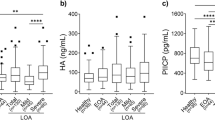Abstract
The objective of this study was to investigate adiponectin levels in both plasma and synovial fluid of female patients with knee osteoarthritis (OA) and to analyze the correlation between adiponectin and degradation markers of cartilage matrix in synovial fluid. Thirty female patients with knee OA were enrolled in this study. Levels of adiponectin and degradation markers of cartilage matrix were measured using enzyme-linked immunosorbent assay. Adiponectin level in synovial fluid was significantly lower with respect to paired plasma level (0.93 ± 0.64 vs. 7.50 ± 3.29 μg/ml, P < 0.001). Correlation analysis showed that synovial fluid adiponectin significantly correlated with degradation markers of aggrecan, AGG1 (r = 0.441, P = 0.015) and AGG2 (r = 0.445, P = 0.014), but not significantly correlated with degradation marker of collagen II, CTX-II. These findings suggest that adiponectin might involve in the regulation of the degradation of cartilage matrix in OA.


Similar content being viewed by others
References
Hochberg MC, Altman RD, Brandt KD, Clark BM, Dieppe PA, Griffin MR et al (1995) Guidelines for the medical management of osteoarthritis. Part I. Osteoarthritis of the hip. American College of Rheumatology. Arthritis Rheum 38(11):1535–1540
Oliveria SA, Felson DT, Cirillo PA, Reed JI, Walker AM (1999) Body weight, body mass index, and incident symptomatic osteoarthritis of the hand, hip, and knee. Epidemiology 10(2):161–166
Cicuttini FM, Baker JR, Spector TD (1996) The association of obesity with osteoarthritis of the hand and knee in women: a twin study. J Rheumatol 23(7):1221–1226
Toda Y, Toda T, Takemura S, Wada T, Morimoto T, Ogawa R (1998) Change in body fat, but not body weight or metabolic correlates of obesity, is related to symptomatic relief of obese patients with knee osteoarthritis after a weight control program. J Rheumatol 25(11):2181–2186
Kershaw EE, Flier JS (2004) Adipose tissue as an endocrine organ. J Clin Endocrinol Metab 89(6):2548–2556
Pottie P, Presle N, Terlain B, Netter P, Mainard D, Berenbaum F (2006) Obesity and osteoarthritis: more complex than predicted!. Ann Rheum Dis 65(11):1403–1405
Nowell MA, Richards PJ, Fielding CA, Ognjanovic S, Topley N, Williams AS et al (2006) Regulation of pre-B cell colony-enhancing factor by STAT-3-dependent interleukin-6 trans-signaling implications in the pathogenesis of rheumatoid arthritis. Arthritis Rheum 54(7):2084–2095
Presle N, Pottie P, Dumond H, Guillaume C, Lapicque F, Pallu S et al (2006) Differential distribution of adipokines between plasma and synovial fluid in patients with osteoarthritis. Contribution of joint tissues to their articular production. Osteoarthr Cartil 14(7):690–695
Schäffler A, Ehling A, Neumann E, Herfarth H, Tarner I, Schölmerich J et al (2003) Adipocytokines in synovial fluid. JAMA 290(13):1709–1710
Chen TH, Chen L, Hsieh MS, Chang CP, Chou DT, Tsai SH (2006) Evidence for a protective role for adiponectin in osteoarthritis. Biochim Biophys Acta 1762(8):711–718
Ehling A, Schäffler A, Herfarth H, Tarner IH, Anders S, Distler O et al (2006) The potential of adiponectin in driving arthritis. J Immunol 176(7):4468–4478
Lago R, Gomez R, Otero M, Lago F, Gallego R, Dieguez C et al (2008) A new player in cartilage homeostasis: adiponectin induces nitric oxide synthase type II and pro-inflammatory cytokines in chondrocytes. Osteoarthr Cartil 16(9):1101–1109
Altman R, Asch E, Bloch D, Bole G, Borenstein D, Brandt K et al (1986) Development of criteria for the classification and reporting of osteoarthritis. Classification of osteoarthritis of the knee. Diagnostic and therapeutic criteria committee of the American Rheumatism Association. Arthritis Rheum 29(8):1039–1049
Li M, Fisette A, Zhao XY, Deng JY, Mi J, Cianflone K (2009) Serum resistin correlates with central obesity but weakly with insulin resistance in Chinese children and adolescents. Int J Obes 33(4):424–439
Arner EC (2002) Aggrecanase-mediated cartilage degradation. Curr Opin Pharmacol 2(3):322–329
Sztrolovics R, Alini M, Roughley PJ, Mort JS (1997) Aggrecan degradation in human intervertebral disc and articular cartilage. J Biochem 326(1):235–241
Martel-Pelletier J, Boileau C, Pelletier JP, Roughley PJ (2008) Cartilage in normal and osteoarthritis conditions. Best Pract Res Clin Rheum 22(2):351–384
Fosang AJ, Neame PJ, Last K, Hardingham TE, Murphy G, Hamilton JA (1992) The interglobular domain of cartilage aggrecan is cleaved by PUMP, gelatinases, and cathepsin B. J Biol Chem 267(27):19470–19474
Ouchi N, Kihara S, Funahashi T, Matsuzawa Y, Walsh K (2003) Obesity, adiponectin and vascular inflammatory disease. Curr Opin Lipidol 14(6):561–566
Kobayashi H, Ouchi N, Kihara S, Walsh K, Kumada M, Abe Y et al (2004) Selective suppression of endothelial cell apoptosis by the high molecular weight form of adiponectin. Circ Res 94(4):e27–e31
Pajvani UB, Hawkins M, Combs TP, Rajala MW, Doebber T, Berger JP et al (2004) Complex distribution, not absolute amount of adiponectin, correlates with thiazolidinedione-mediated improvement in insulin sensitivity. J Biol Chem 279(13):12152–12162
Rubenstein JH, Kao JY, Madanick RD, Zhang M, Wang M, Spacek MB et al (2009) Association of adiponectin multimers with Barrett’s esophagus. Gut 58(12):1583–1589
Hug C, Wang J, Ahmad NS, Bogan JS, Tsao TS, Lodish HF et al (2004) T-cadherin is a receptor for hexameric and high-molecular-weight forms of Acrp30/adiponectin. Proc Natl Acad Sci 101(28):10308–10313
Yamauchi T, Kamon J, Ito Y, Tsuchida A, Yokomizo T, Kita S et al (2003) Cloning of adiponectin receptors that mediate antidiabetic metabolic effects. Nature 423(6941):762–769
Acknowledgments
The authors would like to thank Dr. Jin Jin, Jin Lin, and Xisheng Wen for their help in sample collections and Linxin Xu for technical assistance.
Conflict of interest statement
The authors declare that they have no conflict of interest.
Author information
Authors and Affiliations
Corresponding author
Rights and permissions
About this article
Cite this article
Hao, D., Li, M., Wu, Z. et al. Synovial fluid level of adiponectin correlated with levels of aggrecan degradation markers in osteoarthritis. Rheumatol Int 31, 1433–1437 (2011). https://doi.org/10.1007/s00296-010-1516-0
Received:
Accepted:
Published:
Issue Date:
DOI: https://doi.org/10.1007/s00296-010-1516-0




